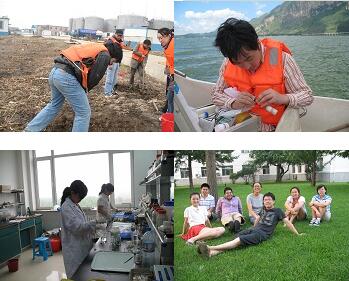Group leader: Prof WANG Shaofeng.
Group members: Associate Prof WU Xing, CHI Guangyu, LI Bo.
Research assistant: ZENG Xiangfeng, ZHANG Danni, YUAN Zidan and ZHAO Feng.
Arsenic pollution in soil and water body Is an important global environmental and public health problems. The toxicity of arsenic is closely related to its existforms in environment and dependent on pH, oxidation-reduction potential, organic matter and coexist ions. The sediment of ground water and surface water generally show anaerobic conditions where the arsenic geo-chemical behavior and related mechanisms still have unsolved mysteries. The group investigated the interactions and form transformations between iron and arsenic, illustrated the adsorptivity to arsenic of iron oxide suspensions formed in sulfate system at various pH. The results show that: 1) In Sulfate medium and under acidic pH, ferrihydrite transformed only to gothite, but in nitrate medium, the major product of transformation is hematite with less gothite. Gothite is not the intermediate product of the transformation. In sulfate medium under alkaline pH, the major product of the transformation is hematite, aside with some gothite, but in nitrate medium, gothite would not formed, the transformed product is hematite only. In sulfite medium, the crystallization-transformation rate of ferrihydrite is less affected by pH, but in nitrate medium under alkaline pH, the crystallization rate of ferrihydrite is higher than that under acidic pH. 2) When iron-arsenic mole ratio is bigger, arsenic released into aquatic phase is relatively low, the inhibition of arsenic to the transformation of iron oxide is not significant. But under strong alkaline conditions, the crystallization of amorphous ferrihydrite is accompanied by the re-sedimentation of ferrihydrite. The samples formed under strong alkaline or acidic conditions, crystallization rate is higher than that under weak alkaline or acidic conditions.
The group investigated also conditions and technology for microbial oil production and found that after Pseudomonas Aeruginosa was strengthened, the abundance of petroleum hydrocarbon degrading bacteria and surfactant producing bacteria increases, but the abundance of harmful sulphate reducing bacteria and iron bacteria decrease, indicate that the anaerobic conditions significantly inhibit the ability of bacteria in synthesize surfactants.
